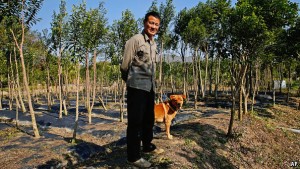
Mr Yeung forsook city life to keep bees on the carefree (and car-free) island of Lamma, a couple of miles from the main island of Hong Kong where the territory’s government and financial centre lie. Lamma’s tropical gardens and verdant jungle are magnets for nature-lovers like Mr Yeung. They worry, however, that one of the most cherished species, the incense tree (Aquilaria sinensis), faces a growing threat to its survival.
The evergreen tree is endemic to southern China. Its lightly scented timber is used to make incense sticks. When damaged, the tree’s aromatic resin may develop into a dark, dense substance known as agarwood, which is prized for its supposed medicinal properties. Trade in the tree’s agarwood produce was once so important locally that a port handling such business was named “fragrant harbour”. The British later applied that name “Hong Kong” to the colony they founded around the port. The commercial harvesting of agarwood trees ended in the territory more than a century ago. Nowadays most agarwood specimens are growing in the wild, including in woodlands preserved by ancient villages.
To protect agarwood trees, the Convention on International Trade in Endangered Species of Wild Fauna and Flora restricts trading in agarwood. But Hong Kong does not single out those who destroy or damage the agarwood trees for harsh treatment. If an incense tree is on government-managed land, the maximum sentence for cutting it down is the same as it is for felling any other kind of tree on such property: a fine of HK$25,000 ($3,210) and a year in prison.
Such penalties do little to deter thieves from mainland China, who are encouraged by growing demand for exotic medicines among members of the mainland’s fast-growing middle class. Professor C.Y. Jim of the University of Hong Kong reckons that in 2013 high-grade agarwood was worth $1,600 a gram on the black market. That is more than gold. According to Mr Jim, Hong Kong may be the “last refuge” of the tree, so it has become a “honeypot” for tree-snatchers.
Most of the thieves work for criminal gangs based across the border in mainland China. In recent years a relaxation of restrictions on travel from the mainland to Hong Kong has made their work easier. They often pretend to be hikers, sometimes camping out for weeks while gathering the timber. A local NGO has produced a map showing about 200 sites from which it says around 500 agarwood trees were stolen in the past year. Ho Pui Han, who runs the group, says there may be only 100 mature trees left in the territory. She is incensed.
Very few incense trees form agarwood, so they are often destroyed indiscriminately. On Lamma, a plaque marks a spot where three young trees were uprooted. A short scramble up a steep slope reveals a gorier scene: splintered woodchips are all that remain of an aged tree. Mr Yeung, the beekeeper, says “hunters” felled and butchered it in situ. As supplies diminish, the gangs are becoming more desperate. Thieves are raiding private gardens; some residents have begun organising patrols to frighten the agarwood thieves away. Alarms and monitoring cameras are being installed.
Ms Ho says the “sacred” relationship between villagers and woodlands is a vital part of Hong Kong tradition. “Their ancestors told them they must not cut down one single tree,” she says. Several thieves have been arrested recently (including on Lamma). But conservationists say the government has to try much harder.

